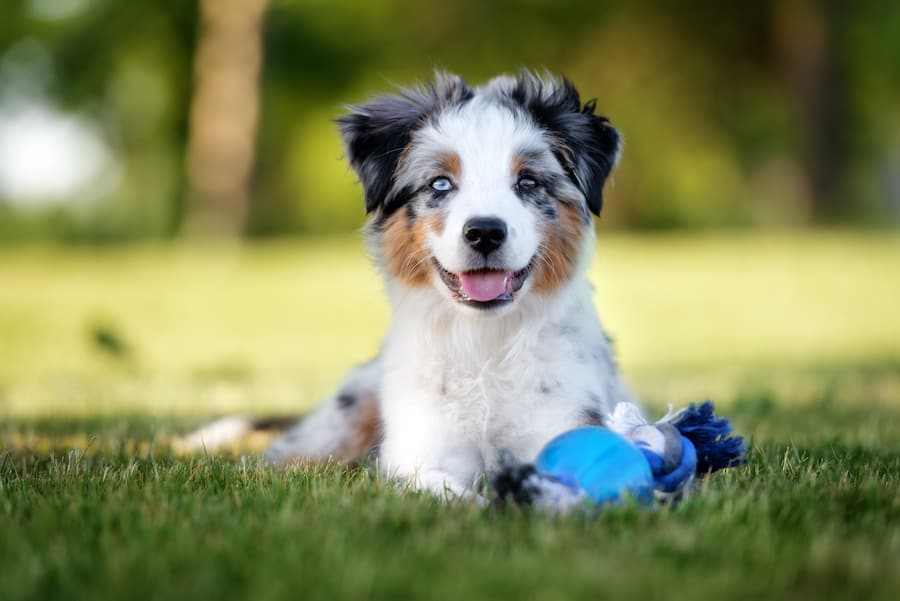Find out how to train your puppy, including commands and training tips. Learn why early socialization is important. You will understand the basics of training your new puppy using positive reinforcement and clicker training and more…
Let’s get started…
Do you ever wonder what are the magic words or commands for training your puppy?
Are there any?
Having a great companion that does what you asked is pretty essential for all concerned.
Safety, health, playing, training, obedience, and fun.
The loyalty, love, and protection that Australian Shepherd’s bring will be a great asset to your family, but you NEED to make the time to work with them.
Are there special words, phrases, or commands that work better than others?
Training your Australian Shepherd puppy is a lot of fun for you and for them.
Having fun and being rewarded for doing something that you want them to do is going to be incredibly satisfying.
This article is a starter guide to things that will help you have the most success with your new Australian Shepherd puppy. You will learn:
- How to begin or start Training
- What types of Routines, what are they and now to use them?
- Why do you need to start Socializing?
- How to use Whistles and clicker for better control
- Voice Commands and how to use them
- Controlling the Nipping
- Not confusing your puppy with Commands
- Potty Training your Pup
- Choosing the Right Nutrition
- Foods to absolutely Avoid feeding your puppy
Let’s dive into how we can make it easier for all the family to have fun and a great relationship with your Aussie Shepherd…

Let’s start from the beginning…
Does this sound familiar?
“Brutus, Come here…”
You know the story with your new puppy…
***Crickets***
Puppies don’t really seem to hear what you are saying because they are so excited with what is going on in front of them at that moment.
They are full of energy, and so happy to see you when you come home from work.
They can’t wait to play with everybody as soon as they see you.
But a puppy, they do have a mind of their own. Haha, don’t we all?
When it comes to doing what you want the puppy to do, – versus what the puppy wants to do. You’re finding you’re getting two different things.
A common problem, right?
You’ve tried everything…. you wind up yelling, you’ve tried kindness, treats, hugs, and everything you can to get your puppy to do what you want.
But nothing seems to work and the only result you’ve gotten is frustration….
You will soon see that Australian Shepherds are really smart. It is a trait of theirs. Intelligence!
So, what can you do?

You generally don’t have much choice when the puppy is so young.The pip is going to be a pup – so it’s ok once in a while to just let the pup be a pup.
Discover, Sniff the new environment and familiarise themselves with their area, enjoy playing.
That puppy is so distracted by whatever is going on that everything is exciting and the attention to stay focussed is…
Non-existent.
But a puppy is a puppy (infant) and that is what they do.
So how can we train the puppy to create good habits that are in line with how you want your Aussie to be later on?
Well, the secret lays in…
You and your ability to make the time to train your new found ball of energy and fur.
Luckily there are several things that can be done to help.
Here are 5 easy Australian Shepherd training tips to get started with your new puppy.

Training 101
Australian shepherds are very smart as you know.
In fact, they are highly intelligent which makes them quite easy to train. But you MUST have the patience and time to spend with them. It will pay dividends later on into adulthood.
When they are between the ages of six months and two years they can be quite boisterous because they are full of energy.
Positive reinforcement is the key here. Aside from the cruelty of it, being heavy handed has never worked for any breed if you want actual cooperation.
Training should always start when they are somewhat calm. Jumping around is not optimal. You need a calm time and the same time in the same area.
They need to know what is happening at the time and place. They will love the training and rewards that come with it.
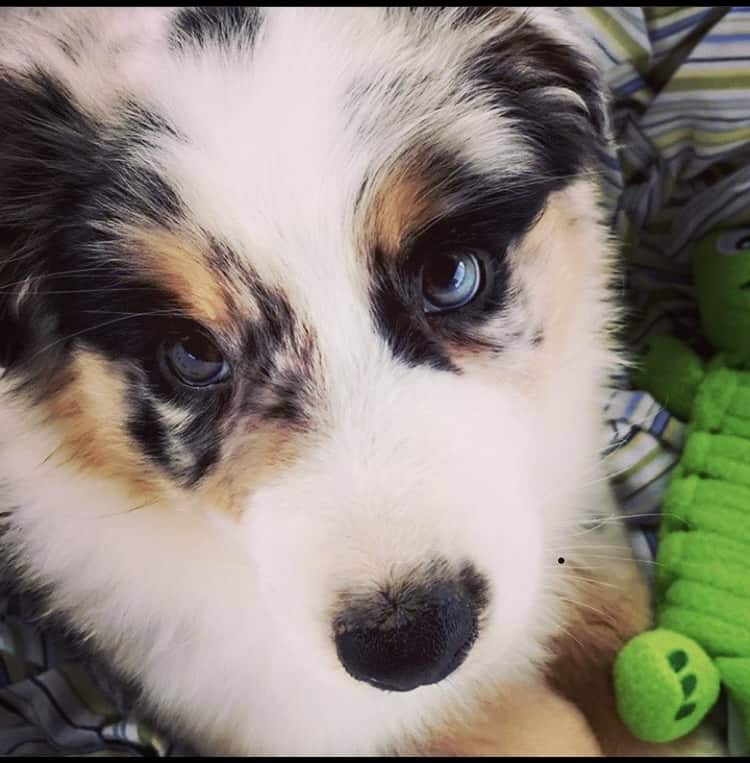
When To Start Training
As soon as you get the pup home you want to try and offer rewards, treats, and hugs. But optimally you’ll find that around the eight-week mark, they will start to soak up all the learning you can give them.
Andthe best part is they will be eager to please.
Remember, the sooner you start training the better. You’ll be able to keep control much easier.
Routines, We All Need Them
And so does your pup.
Because your Aussie is smart they observe everything that goes on. Aussies make mental notes of everything and anything. They get really good at figuring everything out. Your pup will quickly start to learn what is what. Timing becomes a big part of their routine.
In fact here are just a couple of routines that you could possibly relate to:
- (A) they know exactly what time you come home from work . (if they don’t yet, they will!)
- (B) They know what time they get fed.
- (C) They know when the vicious mailman swings by.
- (D) and when it is time to play or train.
Routines, you use them to organize yourself in your life, and so does your Australian Shepherd puppy.
Playtime is very important and should be regimented in some way.Aussies have energy for herding long hours. It certainly will have energy to burn from laying around waiting for you to get home from work.
If you don’t build a solid routine, your lifestyle could be disrupted by your Aussie being anxious and frustrated. Structure. They love structure.
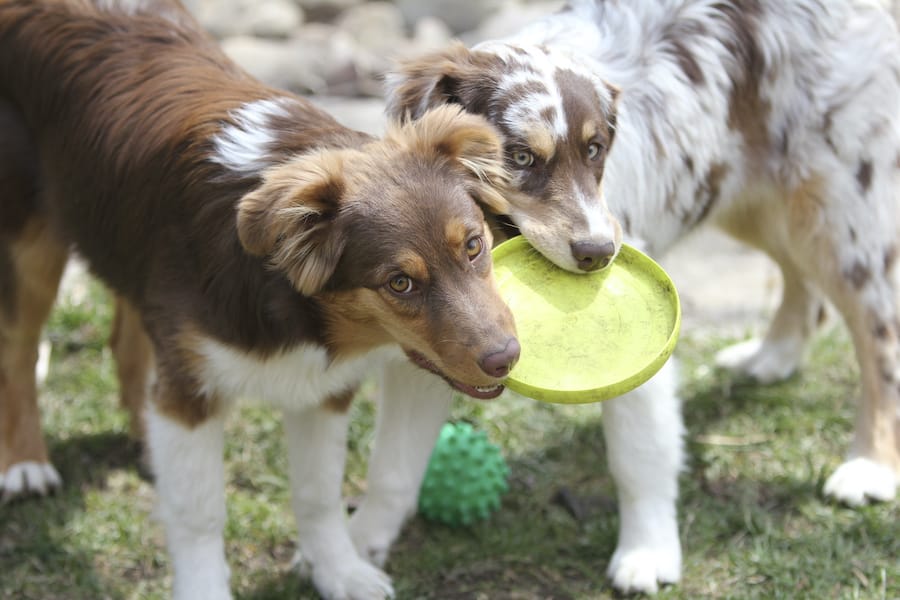
Socializing Your Australian Shepherd Puppy.
With Aussie’s being very strong-willed and protective toward their family it is important to get the puppy socializing early.
There are so many new sounds and things to discover. And they WILL want to discover ALL of them.
You will find that if very little socializing is done, the pup will grow up to be somewhat shy.
Possibly even aggressive towards strangers. They become very wary. And they will always want to protect.
The best thing to do is get them mixed with other animals and people early on.
Introduce your dog to the people that you regularly see.
The Mailman the UPS guy this — becomes part of their routine. They are less likely to bark and lose control if they recognize the people they know.
Exercising and Walking Your Aussie Puppy
Walking and exercising is important. It needs to be done safely.
A short lead is ideal for starting the walks.
Dogs always want to lead – they are bred like that.
You must be the one that leads. You have to be the first one out the door. Teaching the dog who is dominant and who is in charge.
Have them walking beside you or behind you, not in front.
You are the leader of this pack.
The Alpha Dog.

If the dog winds up in front of you, he will think he is the leader.
He will dominate the exercise program or pull you in the direction he wants to go.
Your Australian Shepherd’s exercise needs to be high on the priority list of things to do.
They need to expel a lot of energy. Daily exercise is key to a happy, non-destructive Aussie.
Whistle commands for you Australian Shepherd
Sometimes, using certain commands, words or phrases won’t work.
Have a whistle that you can use to train the dog to come, sit or stand then supply a treat of some sort. A Whistle always works well with certain tones for certain commands.
Using a clicker is also a great way to bring their focus back on you (Note: The clickers I use come in an inexpensive 7 pack, so I can always have one in the room. I get them HERE).
This will make it easier for you to stop the dog from possibly running out on the road and to get them to come back to you when you want them to.
Don’t forget the reward for following your instructions.
Positive Reinforcement!

How to use Voice Commands to train your Australian Shepherd
Worrying about voice commands too much can be detrimental to you as well as frustrating.
Especially at the early stages of your pups development.
When it comes to using your voice for commands it is important to reward for the command.
Tonality is also very important for the pup to understand if you are being stern.
As the theme has started to emerge with this writing you will notice that the one true element in all the training is consistency.
In your voice commands it is just as important to keep up with being repetitive and consistent.
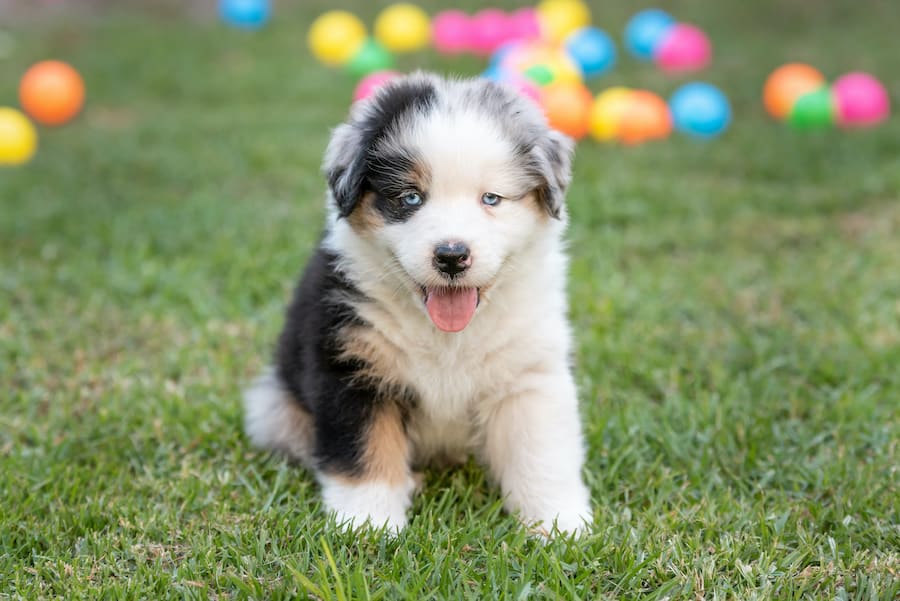
Teaching Your Aussie Pup To Sit
To make your Aussie sit, take a treat and hold up your hand up to their nose. This will make the pup automatically and naturally sit down. After he has sat down repeat the word “sit” so he clearly hears you. Then give him the treat.
Mastering this is easy enough if you stay focused and keep the repetition up.
Repeat the process when giving his food.
Make them sit.When walking on the street and you come to a crosswalk or crossing the road. “Stop, Sit, Reward” Hugs, treats or playtime are all good rewards.
How To Get Your Australian Shepherd Puppy To Come
When your dog sees you coming towards them they become really excited. You want to have the same enthusiasm when you see him.
When you’re ready to start training them to “come” you will want to get someone to hold them while you move to another room.
Once you are out of site, you will want to use the word “come” and say the pup’s name. Be sure to have voice inflection and excitement at your command.
Reward them for being a good pup with praise, a treat or by giving them a hug.
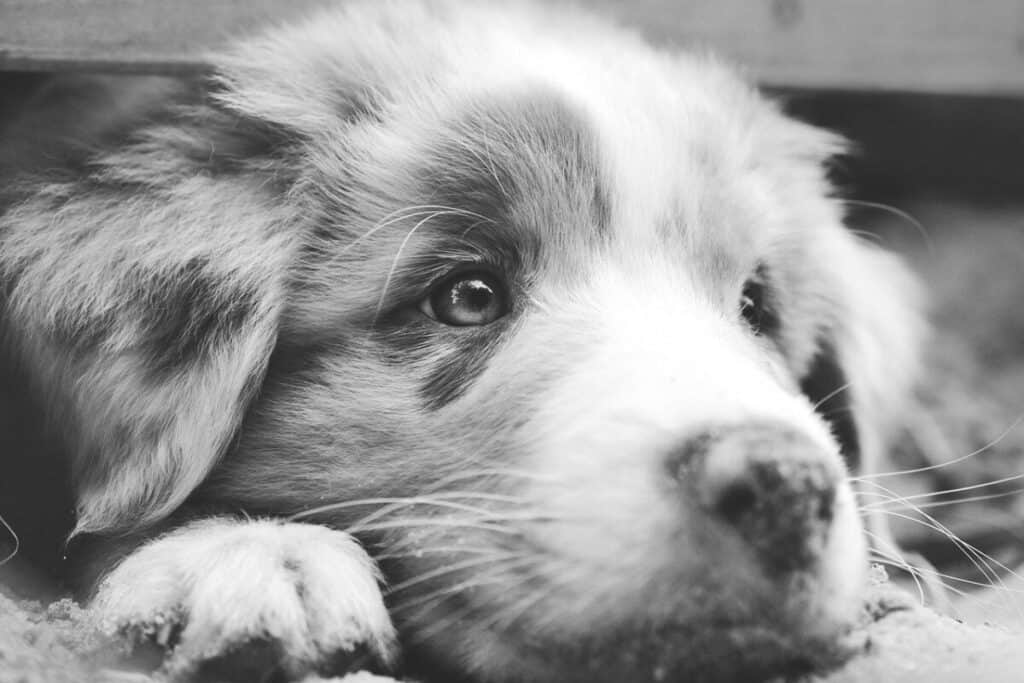
Teaching Your Puppy The “Down” Command
Teaching the down common to your Australian Shepherd is always a good command to teach your puppy. They all love to jump up and get all over anybody. This is not good and can cause a little mayhem.
The technique for getting them to lie down is similar to the sit, movement.
Have the dog sit and then using your hand with the treat gesture to the floor he will follow the treat. At first this might not succeed. Just try again and again. She will catch on, some take a few more tries than others.
Getting your Australian Shepherd To “Stay”
Getting your Aussie to “stay” is a little more difficult to master. However you will get it and so will the dog.
It’s best to have mastered the “Sit” and “Down” commands first. As they will need to have a starting point.
With your hand held up in front of you step back a couple of steps. Repeating the word “Stay”.
Should they come forward just step back to them and get them to “sit” once more.
When you have managed to get him to stay slowly increase the length of time you want them to stay in the position.
The longer the better.
With practice, the dog will understand what you are wanting and comply.
Again, reward them for a good job.
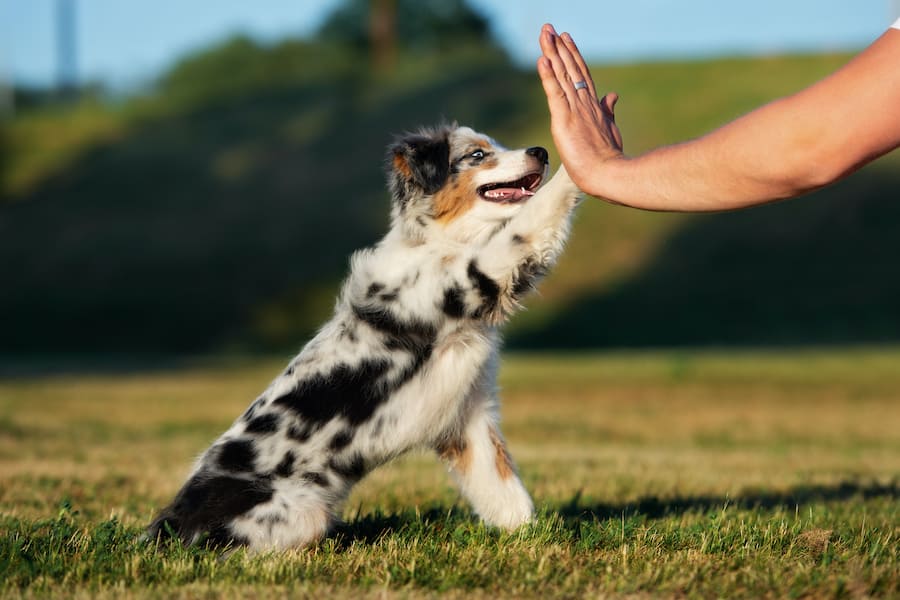
Don’t Confuse your New Puppy
If you don’t have consistency across the training in and out of the house there will be confusion in your puppy’s mind.
This is typically mixed messages from different people.
I.e: If one person gives instructions that stops the pup from jumping up and another person does things that encourages the pup to jump — then the puppy will be confused and will wind up doing whatever he wants.
As a family, there should always be some ground rules for consistency. It is everybody’s responsibility to provide love, safety and training of your new family member.
How to Control Your Nipping Australian Shepherd
Pups use their mouths to discover, play and explore.
So whatever gets near them they are going to nip and bite. As you might imagine, this can start to get a bit annoying after a while.
You will have to set strong guidelines and boundaries that everyone follows. Make them consistent. Like everything else when training.
Have a few cuddly toys. Keep an odd piece of rope for a playful game of tug-o-war. Grab a ball that is not filled with air. After a few bites of the ball holes will appear and the ball is not so much fun anymore.
If you are giving them soft toys to chew make sure that the toys do not have hard pieces like buttons or plastic eyes on them. These can be chewed off and swallowed.
Distracting the pup from nipping is ideal; try giving them something else to think about.
If the biting and nipping continue then use a firm “NO” and stop engaging with your puppy.
They will quickly realize that if they don’t stop biting then they won’t be able to play.
Absolutely don’t physically harm your puppy. You can gently push him away or lightly grab hold of this skin around his neck to get his focus…but usually a “NO” will do the trick.
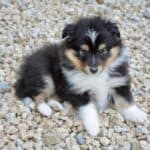
Potty Training Habits & Housebreaking Your Australian Shepherd
Dogs have a genetic ability that will not allow them to mess their Dens. From about two to four months your pup will become programmed to do their business outside as this is part of their genetic makeup.
First thing in the morning take them to a familiar place outside or the general area where they can feel safe. You want to make this part of the regular routine.
You should reward them with praise for doing well.
This doesn’t have to be big High Fives or anything like that but a little treat or quiet well done.
Later on you will notice that they will give you indications that they need to go.
Standing by the door looking anxious or weaving back and forth is what I notice in both of mine.
When it comes to accidents, don’t make a big deal about it.
Stay calm and move quickly to a place where you want them to go. Do not punish them with harsh words, physical harm or create anything negative towards them. They will associate the negativity from you with their normal bodily functions.
Wanna learn more about potty training your new puppy? Click here: 6 Steps to Easily Potty Train Your Australian Shepherd.
I would like to conclude with two things that I find quite important for the well-being of your new family member.
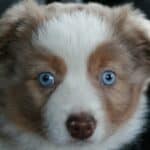
Choosing the Best Nutrition For Your Aussie Puppy?
The best advice I can give you is to talk with your veterinarian. They will give you proper advice as to the type of food and when. What their weight should be at a certain age, etc.
When you do start regular feeding times beware of how the dog reacts to the food. Some dogs, like cats and humans can develop allergies to certain foods. Are they scratching more than normal? Has their skin changed conditions?
A good sign of good healthy dogs is the coat condition. Does it look healthy?
Your pups vet will also be able to advise you on what sort of medications you will need for Fleas, Ticks and Heartworm, along with what you can expect from your pup as they get older.
Your Vet will also give you advice about an exercise program if you haven’t found one that works for you.
Treats are also important to your puppy’s overall well-being and teeth.
Whether they be tooth cleaning treats and all.
Read more on Aussie Nutrition in our resident veterinarian Dr.Tatiana da Silva’s articles What Should I Feed my Australian Shepherd
Foods you Should Never Give Your Australian Shepherd
Chocolate & Caffeine
Chocolate is really bad for your dog and puppy. The most deadly kind of chocolate is baking chocolate. Think of those chips you add to your brownies or cookies.
Chocolate and coffee contain a product called methylxanthine that can cause vomiting, diarrhea, panting, excessive thirst and urination, hyperactivity, abnormal heart rhythm, tremors, seizures and even death. According to the American Society for the Prevention of Cruelty to Animals (ASPCA)
Garlic Onions Chives-
Could cause intestinal irritation
Salt and Salty Snacks-
May cause dehydration thirstiness and urinary issue
Nuts-
Almonds, peanuts and macadamias are especially dangerous for pets
Grapes and raisins-
There Is a toxic substance within grapes and raisins that can cause kidney failure pretty quickly in dogs. The toxic substance is unknown but these fruits must be avoided.
Alcohol-
Don’t even mess with small amounts of alcohol. This doesn’t just have to be in cocktails remember there are various syrups and raw bread dough that can have ingredients in them that are poisonous for pooches. The chemicals ethanol (the intoxicating agent in beer, wine and liquor) and hops (used to brew beer) can cause alcohol intoxication in your dog. If you suspect your dog has ingested alcohol, call your veterinarian right away. A sign of alcohol intoxication could include: vomiting, abnormal mood, disorientation, high body temperature, restlessness, excessive panting, muscle tremors and seizures…
Any Artificial Sweeteners with Xylitol
Xylitol is a type of artificial sweetener found in many sugar-free products like gum and candy, as well as some nut butters like peanut butter. Xylitol can cause insulin release, which can lead to liver failure, seizures and brain damage in your pet.


